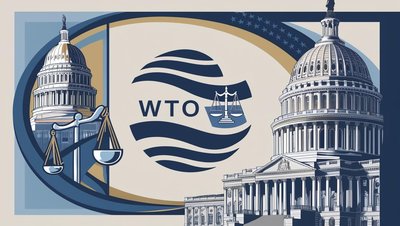6 May 2025
The end of the Pax Americana?
Legal dimensions and considerations of the USA tariff policy from a WTO law perspective
Written by: Thomas Cottier
The United States is undergoing a fundamental shift in trade policy. The era of open markets is coming to an end, replaced by a new strategy centered on import substitution. These changes are essentially designed to fulfill the promise of rebuilding industry in the rust belt of fly-over states in the US Midwest.
On April 2, 2025—referred to by some as “Liberation Day”—the United States introduced sweeping protective tariffs, marking a dramatic departure from the international trade order that has prevailed since the end of the Second World War. This moment may well signal the end of the Pax Americana, a post-war period of relative global economic stability under U.S. leadership.
Never in the history of international trade relations have tariffs been threatened and used in such a disruptive way. On April 2, massive reciprocal tariff hikes were announced but suspended a week later amid mounting instability in global financial markets. A 10% ad valorem tariff was imposed for three months, while Chinese goods—excluding iPhones—are now subject to a staggering 125% duty. These actions raise the U.S. average tariff to around 25%. The Economist accurately dubbed April 2 “Ruination Day” and questioned how much more strain the global economic system can endure. The United States of America’s citizens’ well-being is not at the center of their efforts.
These tariffs serve multiple purposes: they are fiscal tools, instruments for geopolitical bargaining, and a method to pursue concessions in unrelated policy areas. Yet, the objectives of Trump’s trade policy remain unclear in detail. In all policy areas, the Trump administration is primarily concerned with strengthening the autocratic power of the president and asserting its power both domestically and abroad. In his pursuit of unchecked power, President Trump is undermining legal norms—disregarding international law, weakening the rule of law at home, and eroding the constitutional system of checks and balances, which no longer functions as intended.
The USA is Switzerland's second-largest trading partner after the EU (and Germany). Switzerland is the 8th largest investor in the USA. Because of our close economic relations, the U-turn in US trade policy poses major challenges for our country and its economy. What is the best way to respond? Should we negotiate alone and bilaterally or as part of a new alliance of democratic states? What role should the multilateral and rules-based order play? How must the relationship with the EU be structured so that new restrictions on the part of the most important trading partner can be avoided?
The legal dimension of the current crisis has been strikingly absent from much of the public debate. Yet it is precisely this legal foundation that must guide both analysis and the formulation of an effective response. The Trump administration’s tariff measures clearly violate the United States’ binding commitments under the WTO, including the principle of Most-Favored Nation treatment. These unilateral and punitive “reciprocal” tariffs undermine the integrity of the multilateral trading system. Based on the current legal situation, a quick deal with the USA must be avoided. Instead, the dispute settlement procedures provided for in the WTO should be initiated with a broad alliance of like-minded WTO members. The Federal Act on Foreign Trade Measures must be amended to enact compensatory measures. A temporary national aid program should be introduced to mitigate the economic impact of excessive U.S. tariffs and to redirect strategic investments—potentially even toward regions like the U.S. Midwest—to maintain economic engagement under new conditions.
Edited and translated by Samantha Suarez


